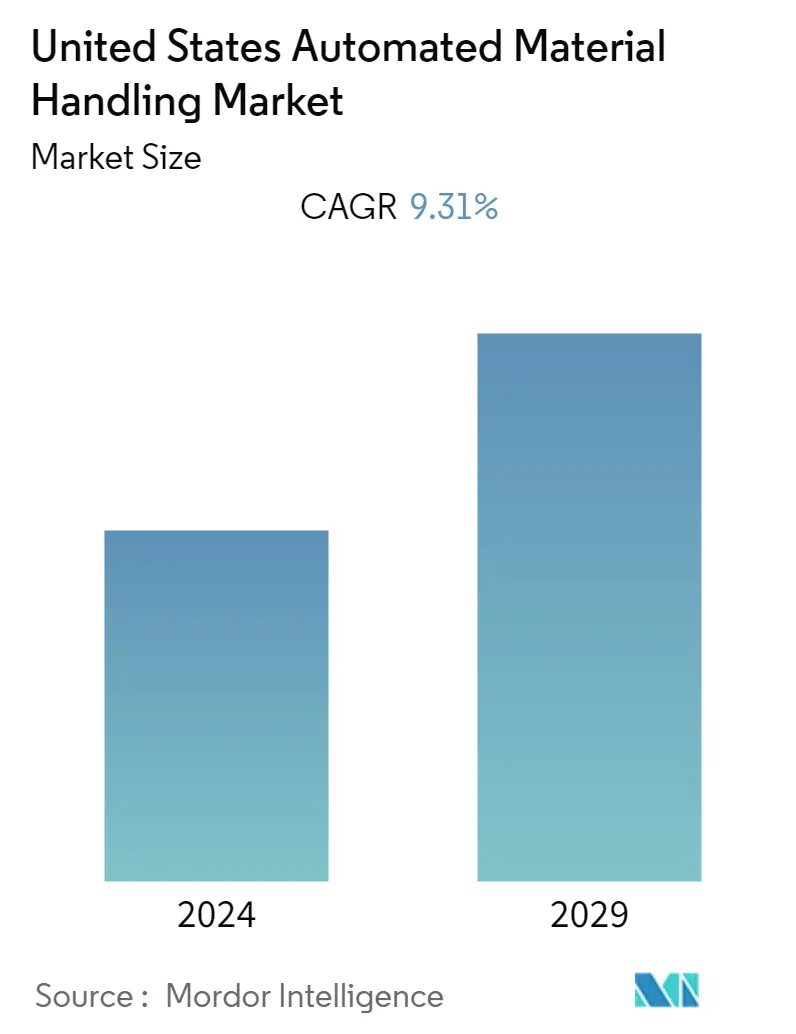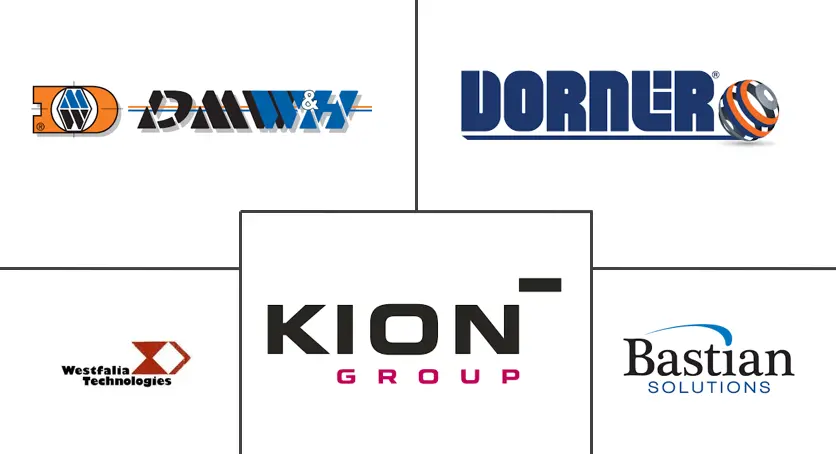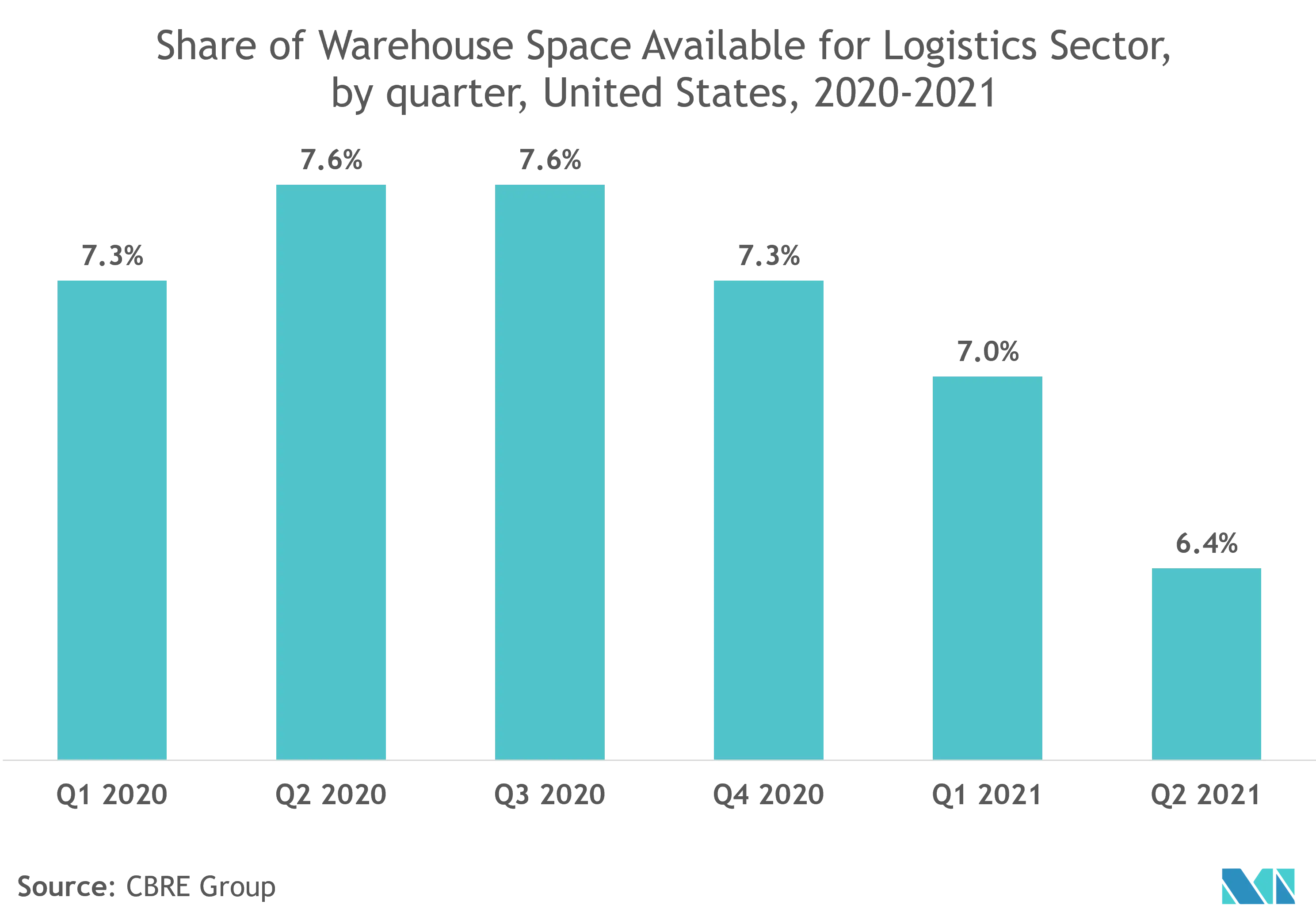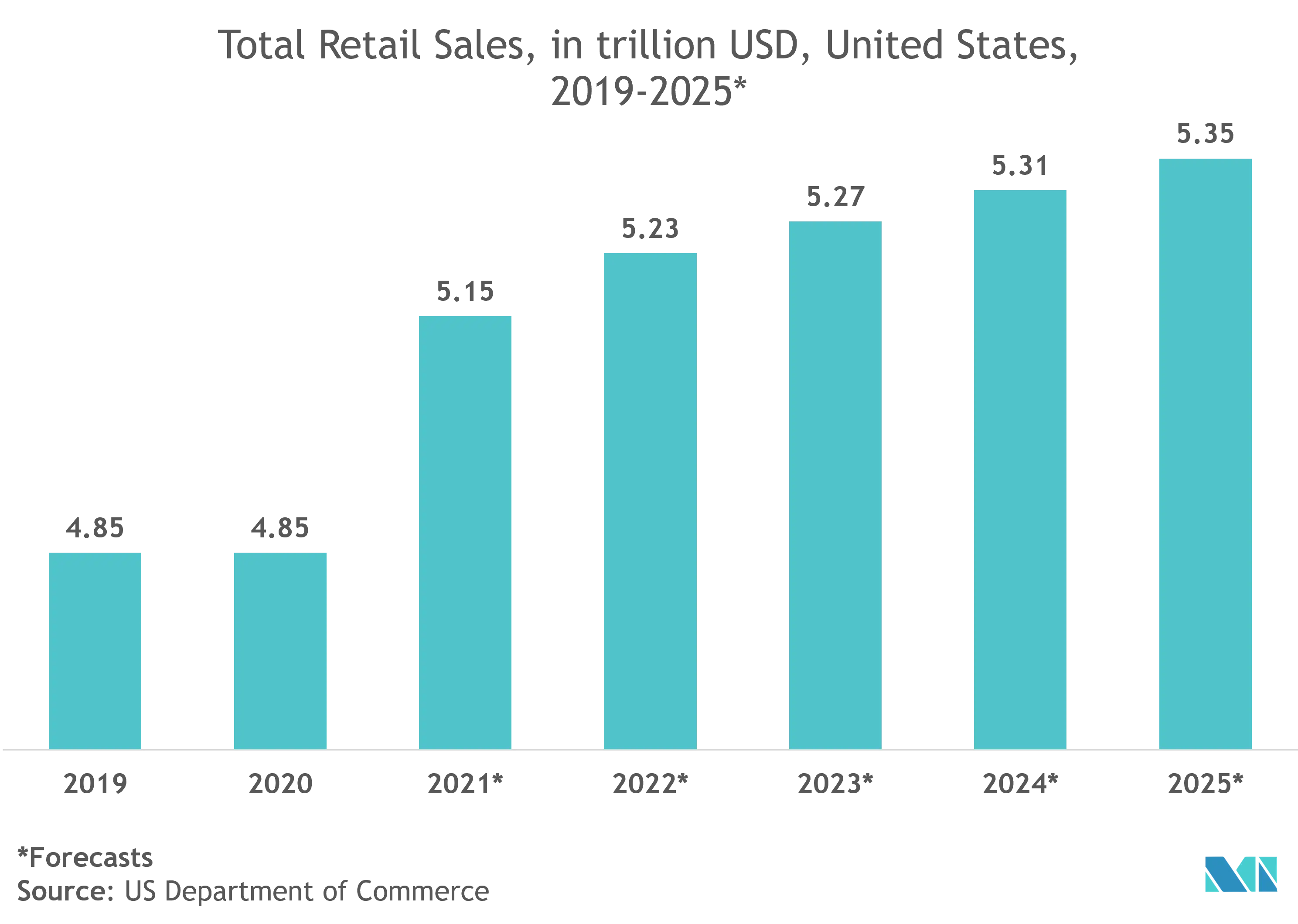US Automated Material Handling Market Size

| Study Period | 2019 - 2029 |
| Base Year For Estimation | 2023 |
| Forecast Data Period | 2024 - 2029 |
| Historical Data Period | 2019 - 2022 |
| CAGR | 9.31 % |
| Market Concentration | Medium |
Major Players
*Disclaimer: Major Players sorted in no particular order |
US Automated Material Handling Market Analysis
The United States Automated Material Handling Market was valued at USD 11685.9 million in 2020 and is anticipated to reach USD 19837.93 million by 2026 at a CAGR of 9.31% over the forecast period (2021 - 2026). Moreover, many warehouse sites have been recovering after starting their operations post lockdown in the United States. However, the fluctuations caused in the starting four months of 2020 resulted in order delays and led time across the warehouse robotics supply chain throughout the year. With the spread of the COVID-19 pandemic last year, robots and automation played a critical role in managing the situation. Furthermore, the situation was likely to bring new opportunities to the market.
- The United States is the most advanced economies in the world. The country's manufacturing sector, which is a huge source of demand for the AMH market, hinges on the dominant US economy, accounting for 82% of the region's economic output.
- Moreover, United States is one of the major investors and innovators in the global AMH market owing to the high rate of technological advancements among regional AMH manufacturers, such as automation, AI, and machine learning, and are rapidly driving the industry forward. Increasing demand for advanced automated material handling systems and ever-increasing labor costs with the inconvenience of employing a manual workforce in North America is further driving the United States AMH market.
- Modern manufacturing facilities in the country rely on new technologies and innovations to produce higher quality products at faster speeds, with lower costs. Implementing innovative software and hardware proves the only feasible way to survive in the current competitive market.
- For instance, the FDA Food Safety Modernization Act (FSMA) transforms food companies by shifting the focus from responding to foodborne illness and foreign material contamination to preventing it. As a result, cleanability and sanity have become the biggest priorities of belt manufacturers in the US. Stainless steel also emerged as a popular belt type for food processing in the country. The US post offices also witnessed a 60% energy savings in parcel-handling applications after employing roller conveyors.
- Furthermore, the material handling industry in the country has been significantly disrupted due to the pandemic outbreak. Partial operations within manufacturing facilities and distribution centers have resulted in delayed orders for new AMH systems. During the peak pandemic, warehouses that used manual picking had to halt their operations, thus severely impacting the global supply chain. DHL reported that only 5-10% of the fulfillment centers in the United States are using automated systems already.
- However, vendors strived to enhance their AMH product offerings during the pandemic. For instance, in October 2020, StoecklinLogistics, a supplier of innovative supply chain solutions, introduced a line of dynamic MASTerStacker Cranes (unit load ASRS) that feature high acceleration and moving speeds, improved energy efficiency, and modular construction that delivers vastly improved performance and high levels of availability. The new cranes also have more straightforward and faster wheels and hoists, greater standardization across different cranes and load-carrying capacities, shorter assembly and manufacturing times, lighter construction, and improved accessibility to components for maintenance.
US Automated Material Handling Market Trends
This section covers the major market trends shaping the US Automated Material Handling Market according to our research experts:
Autonomous Mobile Robots (AMR) is Expected to Hold Significant Market Share
- AMRs are replacing AGVs in logistical applications. This is because, unlike AGVs, AMRs incorporate more sophisticated onboard computers that are coupled to inertial measurement units (IMU), laser scanning range finders, 2D and 3D color cameras, and motor controllers. Such AMRs do not require tracking strips to be placed in a factory or warehouse.
- Moreover, it is expected that AMRs would gradually replace forklifts in particular too. Further, Mobile Industrial Robots Inc. has taken the first initiative to design the MiR1000 AMR. It can tolerate a payload of 1000kg and equip with six laser scanners, 3D cameras, and an artificially intelligent camera.
- While many logistics operations still rely on manual and paper-based picking systems, autonomous mobile robots can now eliminate a lot of unnecessary walking. According to US Census Bureau data analysis, the average warehouse worker wastes nearly seven weeks per year in unnecessary motion, accounting for more than USD 4.3 billion in labor.
- Moreover, the North American airport industry is one of the largest airport industries in the world. It provides services to about 1,011.5 million domestic and international passengers every year. It is also home to some of the world’s biggest airports and is expected to bolster the adoption of automation to ensure no disruptions in the business model. For instance, Crisplant, a foremost global supplier of automated baggage handling systems, designed, manufactured, and installed fully automated baggage handling systems, integrated with the security screening equipment deployed by the Canadian Air Transport Security Authority (CATSA), in Canada’s Halifax International Airport.
- Further, vendors in the studied market are expanding their foothold in the region by the merger and acquisition strategy. For instance, in May 2020, Geek+ and Conveyco entered into a strategic partnership to accelerate access to AMR (Autonomous Mobile Robot) solutions in North America, especially in the United States. The demonstrated efficiency, scalability, and cost-saving of Geek+ solutions will bring significant value and enable flexible logistics for customers across industries in the region through this partnership.

Retail Industry is Expected to Hold Significant Market Share
- The significant growth of the United States retail and e-commerce sector and warehouse expansion is becoming a primary driver of market growth. Most of the region's retailers plan to automate their warehouse establishments rather than expand in a high-priced rental environment. According to the Robo Business Warehouse Automation Report, almost 80% of the United States' warehouses are still manually operated. Only 15% of all the warehouse establishments were mechanized, and not more than 5% were automated. This provides a long runway for the AMH market to grow consistently across the country over the forecast period.
- Moreover, the United States stands to be one of the major retail markets in the region. It is estimated that more than two-thirds of the country's GDP is generated from retail consumption every year. In the country's e-commerce sector, the sales growth continues to increase more than the physical stores. With automation being the key differentiating factor, there is increasing competition between online and omnichannel retailers.
- Retail is one of the major industries, wherein the requirement for automated material handling systems such as conveyors is essential. It immensely helps online retailers with the movement of goods and increases good delivery efficiency. Furthermore, retailers are increasingly investing in expanding warehouse space. For example, Blackstone Group invested USD 18.7 billion on 179 million square feet of US warehouse space to cater to the country's growing retail demand. Amazon.com Inc is another such example, adopting automation techniques to solve its warehouse growing problems. In recent years, the company has been rolling out automated material handling machines and has added many advanced conveyor technologies to its warehouses.
- Multiple companies in the region are starting fulfillment distribution centers with the growing demand from e-commerce channels. For instance, in December 2020, PFS announced its new fulfillment distribution center in the Dallas area and operated e-commerce fulfillment programs for four brands. The fulfillment centers are generally equipped with several conveyor systems to efficiently transport products, and such expansion activities are expected to impact the conveyor market in the United States positively.
- However, the outbreak of COVID-19 dented the retail sales in March, April, and May in 2020. Such factors negatively impacted the usage of automated material handling in the United States' retail landscape in those months. However, the retail sector witnessed a significant surge in late 2020, which bounced back the usage of automated systems such as AMH.

US Automated Material Handling Industry Overview
The United States automated material handling market is fragmented and highly competitive. Product launches, high expense on research and development, partnerships and acquisitions, etc., are the prime growth strategies adopted by the companies in the country to sustain the intense competition.
- January 2021 - TGW Logistics Group planned to sell certain US conveyor assets in Norton Shores (Michigan) to Material Handling Systems, Inc. (MHS). The contract between the two companies has been signed, and the acquisition is expected to take effect by the end of 2021. Lincoln International guided TGW through the whole M&A process. With the sale, TGW adjusts its strategic portfolio and focuses on the growing integration business in North America.
- July 2020 - Vanderlande created the HOME PICK, based on a goods-to-person (GtP) picking solution that makes use of ADAPTO and is a unique 3D, shuttle-based automated storage and retrieval system (AS/RS). It is ideal for food retailers to realize economies of scale through centralized fulfillment centers (CFCs). By using ADAPTO and modular workstations, HOMEPICK's scalability also makes it future-proof. The sequenced orders ensure the proper order per delivery route and maximum delivery performance, which results in significant time and cost savings.
US Automated Material Handling Market Leaders
-
Kion Group AG
-
Bastian Solutions Inc.
-
DMW&H
-
Westfalia Technologies Inc.
-
Dorner Manufacturing Corporation
*Disclaimer: Major Players sorted in no particular order

US Automated Material Handling Market News
- February 2021- Urban Outfitters Inc. (URBN), one of the providers of lifestyle products and services companies, that operates a portfolio of global consumer brands comprised of Anthropologie, BHLDN, Free People, Terrain, Urban Outfitters, Nuuly, and a Food and Beverage division partnered with TGW to design and implement an automation solution for a new fulfillment center in Kansas City, in the US. The company's FlashPick system is provided as a solution as the product picks orders fully automatically and ensures the next phase of picking is being addressed.
- January 2021- W. M. Kelley Co. Inc., New Albany, Indiana, acquired Louisville, Kentucky, based Lauyans & Co. Inc. Lauyans & Co. to continue providing overhead conveyor and permanent magnet solutions. The acquisition is expected to help W.M. Kelley better position and serve its customers in design and fabrication needs.
US Automated Material Handling Market Report - Table of Contents
1. INTRODUCTION
- 1.1 Study Assumptions and Market Definition
- 1.2 Scope of the Study
2. RESEARCH METHODOLOGY
3. EXECUTIVE SUMMARY
4. MARKET INSIGHTS
- 4.1 Market Overview
-
4.2 Industry Attractiveness - Porter's Five Forces Analysis
- 4.2.1 Bargaining Power of Suppliers
- 4.2.2 Bargaining Power of Buyers
- 4.2.3 Threat of New Entrants
- 4.2.4 Intensity of Competitive Rivalry
- 4.2.5 Threat of Substitutes
- 4.3 Industry Value Chain Analysis
- 4.4 Assessment of the Impact of COVID-19 on the Market
5. MARKET DYNAMICS
-
5.1 Market Drivers
- 5.1.1 Increasing Manufacturing Complexity and Technology Availability
- 5.1.2 Increasing Demand for Improving Order Accuracy and SKU Proliferation
- 5.1.3 Emergence of Smart City Logistics and Wide Adoption of Robotics in Warehouse Applications
-
5.2 Market Restraints
- 5.2.1 Gap in Supply Chain Skills and Workforce Shortage
- 5.2.2 High initial costs
6. MARKET SEGMENTATION
-
6.1 By Product Type
- 6.1.1 Hardware
- 6.1.2 Software
- 6.1.3 Services
-
6.2 By Equipment Type
- 6.2.1 Automated Guided Vehicle (AGV)
- 6.2.1.1 Automated Forklift
- 6.2.1.2 Automated Tow/Tractor/Tug
- 6.2.1.3 Unit Load
- 6.2.1.4 Assembly Line
- 6.2.1.5 Special Purpose
- 6.2.2 Autonomous Mobile Robots (AMR)
- 6.2.3 Laser Guided Vehicle
- 6.2.4 Automated Storage and Retrieval System (ASRS)
- 6.2.4.1 Fixed Aisle (Stacker Crane + Shuttle System)
- 6.2.4.2 Carousel (Horizontal Carousel + Vertical Carousel)
- 6.2.4.3 Vertical Lift Module
- 6.2.5 Automated Conveyor
- 6.2.5.1 Belt
- 6.2.5.2 Roller
- 6.2.5.3 Pallet
- 6.2.5.4 Overhead
- 6.2.6 Palletizer
- 6.2.6.1 Conventional (High Level + Low Level)
- 6.2.6.2 Robotic
- 6.2.7 Sortation System
-
6.3 By End-user Vertical
- 6.3.1 Airport
- 6.3.2 Automotive
- 6.3.3 Food and Beverage
- 6.3.4 Retail/Warehousing/ Distribution Centers/Logistic Centers
- 6.3.5 General Manufacturing
- 6.3.6 Pharmaceuticals
- 6.3.7 Post and Parcel
- 6.3.8 Other End-Users
7. COMPETITIVE LANDSCAPE
-
7.1 Company Profiles
- 7.1.1 Kion Group AG
- 7.1.2 Bastian Solutions Inc.
- 7.1.3 DMW&H
- 7.1.4 Westfalia Technologies Inc.
- 7.1.5 Dorner Manufacturing Corporation
- 7.1.6 Cornerstone Automation Systems LLC
- 7.1.7 Oceaneering International Inc.
- 7.1.8 Aethon Inc.
- 7.1.9 Daifuku Co. Ltd
- 7.1.10 Remtec Automation
- 7.1.11 Siggins Company
- 7.1.12 Honeywell Intelligrated
- 7.1.13 Vanderlande Industries B.V.
- *List Not Exhaustive
8. INVESTMENT ANALYSIS
9. MARKET OPPORTUNITIES AND FUTURE TRENDS
** Subject To AvailablityUS Automated Material Handling Industry Segmentation
Automated material handling equipment eliminates the need for human interference in a material handling process. The continuous rise in demand for automation with the advent of robotics, wireless technologies, and driverless vehicles in different industries like food and beverages, retail, general manufacturing, pharmaceuticals, and post & parcel has revolutionized the adoption of automated material handling equipment. Moreover, the type of equipment such as AS/RS, AGV, conveyor, palletizer, and sortation systems is considered under the market scope. Further, to arrive at the overall market projections, the study analyzes the impact of COVID-19 and the investment scenario and other macro-economic factors.
| By Product Type | Hardware | |
| Software | ||
| Services | ||
| By Equipment Type | Automated Guided Vehicle (AGV) | Automated Forklift |
| Automated Tow/Tractor/Tug | ||
| Unit Load | ||
| Assembly Line | ||
| Special Purpose | ||
| By Equipment Type | Autonomous Mobile Robots (AMR) | |
| Laser Guided Vehicle | ||
| Automated Storage and Retrieval System (ASRS) | Fixed Aisle (Stacker Crane + Shuttle System) | |
| Carousel (Horizontal Carousel + Vertical Carousel) | ||
| Vertical Lift Module | ||
| Automated Conveyor | Belt | |
| Roller | ||
| Pallet | ||
| Overhead | ||
| Palletizer | Conventional (High Level + Low Level) | |
| Robotic | ||
| Sortation System | ||
| By End-user Vertical | Airport | |
| Automotive | ||
| Food and Beverage | ||
| Retail/Warehousing/ Distribution Centers/Logistic Centers | ||
| General Manufacturing | ||
| Pharmaceuticals | ||
| Post and Parcel | ||
| Other End-Users |
US Automated Material Handling Market Research FAQs
What is the current United States Automated Material Handling Market size?
The United States Automated Material Handling Market is projected to register a CAGR of 9.31% during the forecast period (2024-2029)
Who are the key players in United States Automated Material Handling Market?
Kion Group AG , Bastian Solutions Inc., DMW&H, Westfalia Technologies Inc. and Dorner Manufacturing Corporation are the major companies operating in the United States Automated Material Handling Market.
What years does this United States Automated Material Handling Market cover?
The report covers the United States Automated Material Handling Market historical market size for years: 2019, 2020, 2021, 2022 and 2023. The report also forecasts the United States Automated Material Handling Market size for years: 2024, 2025, 2026, 2027, 2028 and 2029.
US Automated Material Handling Industry Report
Statistics for the 2024 US Automated Material Handling market share, size and revenue growth rate, created by Mordor Intelligence™ Industry Reports. US Automated Material Handling analysis includes a market forecast outlook 2029 and historical overview. Get a sample of this industry analysis as a free report PDF download.



